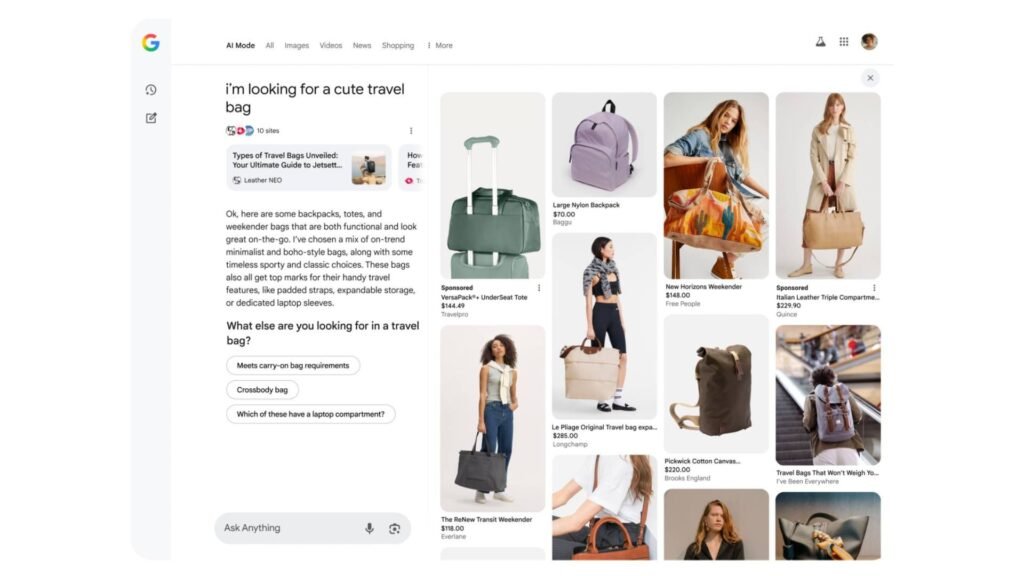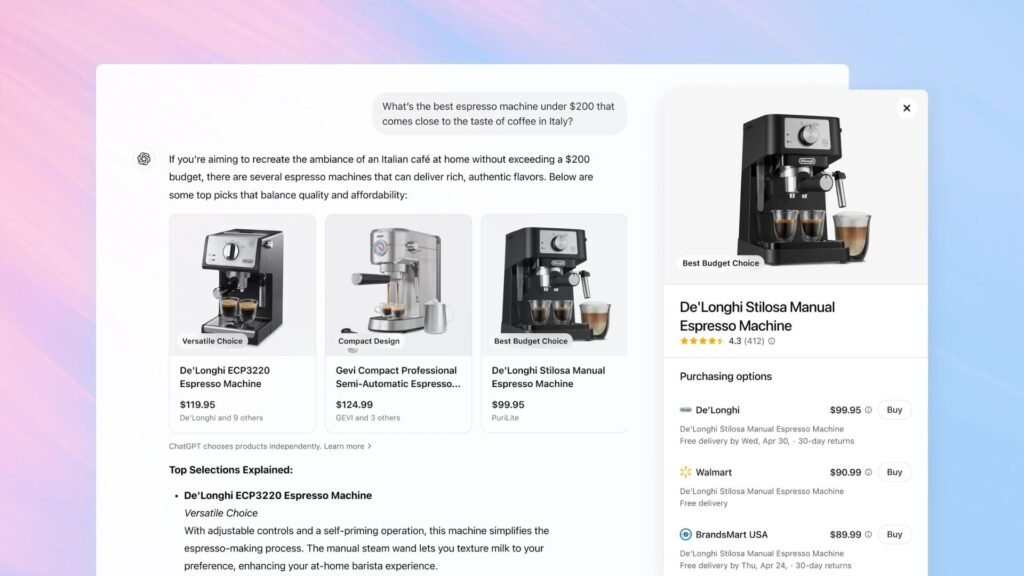Is your AI Shopping Strategy strong enough to keep your business visible in a world where robots are doing the shopping for people?
Imagine you have a super-smart robot friend who can shop online for you. You just tell it, “Find me the best red sneakers under ₹2,000,” and it searches websites, compares prices, checks reviews, and even places the order—without you lifting a finger.
That’s what an AI shopping agent does.
These agents are powered by artificial intelligence (AI), which means they can “think,” learn what you like, and make choices based on your preferences. Some popular tools like ChatGPT, Google Assistant, and Amazon’s Alexa are already moving in this direction. Soon, millions of people might rely on these robot assistants to do their shopping.
Why Do They Matter for Businesses?
If you run a business or sell something online, this is big news.
- In the past, people visited your website, scrolled through your products, and made buying decisions.
- Now, robots might do all that for them—and people will just approve what the robot suggests.
So if your website isn’t ready for these shopping agents, your product might not show up at all—even if it’s great. That’s why building an AI Shopping Strategy has become more important than ever.
Change Your Goals from People to Robots

Let’s say you run an online store. Until now, your main goal was to make people click on your ad, visit your website, and buy something. You’d check how many people saw your post (impressions), how many clicked (click-through rate), and how many made a purchase (conversions).
But here’s the twist in 2025: more and more of that shopping journey is being done by AI agents—not people.
These shopping bots don’t behave like humans. They don’t get distracted by bright banners or catchy slogans. Instead, they quietly scan your site to answer one question:
- “Is this the best option for my user right now?”
So, if you’re a business owner or marketer, it’s time to update your goals. Instead of only asking:
- “How many people visited my page?”
You should start asking:
- “How often do AI shopping agents choose my product?”
- “Is my product showing up in AI-generated suggestions?”
- “When a shopping bot checks my site, can it easily find all the right info—like stock, reviews, price, shipping time?”
These are called agent-focused metrics. They help you understand how attractive your brand is—not just to people—but to robots doing the shopping.
Focusing on these questions is the foundation of a smart AI Shopping Strategy.
Add Structured Data So Agents Understand

Imagine you’re in a library, looking for a book about dinosaurs. But none of the books have titles or labels—you’d be super confused, right?
That’s how AI shopping agents feel when they visit a website that doesn’t have clear information. They don’t “see” the website like people do. They read it like a big checklist. If the info is not labeled properly, they can’t figure out what you’re selling—and they move on.
So What Do These Robots Look For?
They want to know:
- What is this product?
- How much does it cost?
- Is it available right now?
- What do other buyers say about it?
- How quickly can it be delivered?
If this information is clear and easy to find, the AI agent gets happy—and it will recommend your product to the shopper.
This step is a core part of your AI Shopping Strategy, ensuring robots can “read” your content correctly.
How Can You Make It Easy for Them?
You don’t need to be a tech expert. Just make sure:
- Your product titles are simple and clear
- The price is easy to see
- You mention if it’s in stock or sold out
- Reviews are shown right near the product
- Shipping time is written clearly
It’s kind of like giving robots a clean cheat sheet with all the answers they need. If they find what they’re looking for quickly, they’ll trust your site and pick your product.
Make Your Website Clean, Simple, and Easy for Agents to Explore

Think of your website like a shop. If someone walks in and things are all over the place—products in the wrong shelves, no signs, and confusing paths—they’ll walk out. AI shopping agents feel the same way!
These robot shoppers don’t scroll like humans. They don’t “see” fancy colors or moving pictures. They’re looking for clean, organized websites that are easy to read and easy to move around.
A smooth, mobile-friendly website that’s easy to scan is a key part of a solid AI Shopping Strategy.
What Does a “Clean” Website Mean?
It means:
- Pages load quickly (no spinning wheels)
- Menus are easy to understand (like “Shoes,” “Bags,” “Offers”)
- Buttons like “Buy Now” or “Add to Cart” are big, clear, and work properly
- There are no hidden popups that block important info
How to Make It Simple for Robots:
- Use clear words—avoid confusing product names
- Keep your design neat—too many colors or animations can distract the agent
- Use big, clickable buttons—so even bots can “click” easily
- Add image names and short descriptions—so robots know what each picture shows
- Make sure your site works well on phones too—AI agents check mobile versions first
Show Trust to Robots and People

When people shop online, they want to feel safe before they spend their money. They look for signs like good reviews, clear return policies, and secure payment options.
Now imagine AI shopping agents doing the same thing—but much faster.
These smart shopping bots scan websites to see if a product is trustworthy. If your product page looks suspicious, has no reviews, or hides important details, the robot might skip it—no matter how great your product is.
Building that trust through your website is an essential pillar of your AI Shopping Strategy.
So What Exactly Do Robots Look For?
They want clear answers to questions like:
- “Do other people like this product?”
- “Will this item arrive on time?”
- “Can the buyer return it easily if something goes wrong?”
- “Is this a real business, or a fake one?”
If your website shows these trust signals clearly, robots will feel confident recommending you.
Be Everywhere the Robots Are

Imagine this: you’re selling an amazing product online, but no one sees it because you’re standing in the wrong market. That’s what happens when your product isn’t where the AI shopping agents are looking.
AI agents don’t just browse one website—they look across many platforms, apps, and marketplaces all at once. And if your product isn’t listed or easy to find in those places, the bots won’t see you at all.
Listing your products on Google Shopping, Amazon, and Facebook Shops is a must-have part of your AI Shopping Strategy.
In other words: if you’re not where the bots are, you’re invisible.
Watch the Future and Stay Ahead

The world of online shopping is changing really fast—and AI shopping agents are leading the way. What worked last year might not work next month. If you want your business to grow, you need to do more than just keep up. You need to stay one step ahead.
Imagine you’re on a racetrack. AI agents are the fast cars zooming ahead. If your business is still walking, you’ll be left behind. But if you watch where things are going and get ready early, you can ride right alongside the leaders.
What’s Changing in the Shopping World?
Here are some big shifts happening right now:
1. AI Agents Are Becoming Normal
More and more people are starting to use AI tools to help them shop—especially younger shoppers. Gen Z and Millennials are happy to ask tools like ChatGPT or Alexa
Fact: A recent survey showed that over 30% of Gen Z shoppers are already comfortable letting AI assistants make shopping choices for them. That number is expected to rise rapidly in the coming years.
2. Shopping Is Happening Everywhere
People are not just shopping on websites anymore. They’re using Voice assistants, Social media shops, Mobile apps, Smart TVs and even refrigerators
3. AI Agents Are Getting Smarter
These bots don’t just follow instructions. They learn.
So, if your brand isn’t showing up in those preferred categories, you could get left out—without even knowing.
If you’re planning your next AI Shopping Strategy, future-proofing it with regular updates and tech integration is crucial.
Conclusion
AI shopping agents are no longer science fiction—they’re here, and they’re changing how people shop online every single day. Instead of waiting for a customer to find your product, now a robot might find it for them. But only if your business is ready.
Getting ready for AI shopping agents doesn’t mean changing everything overnight. It means starting with small steps—making your product pages cleaner, updating your listings, and learning how these new digital helpers think.
Because the brands that adapt early won’t just survive the future—they’ll lead it.
Your AI Shopping Strategy is not just another marketing plan—it’s your new way to connect with the future of commerce.







